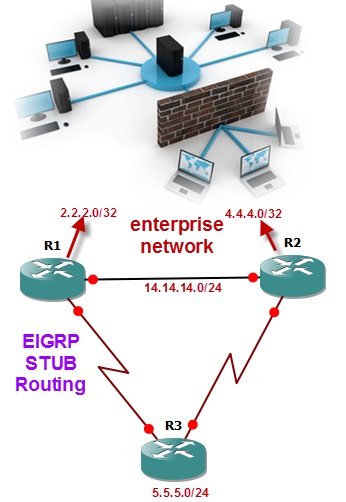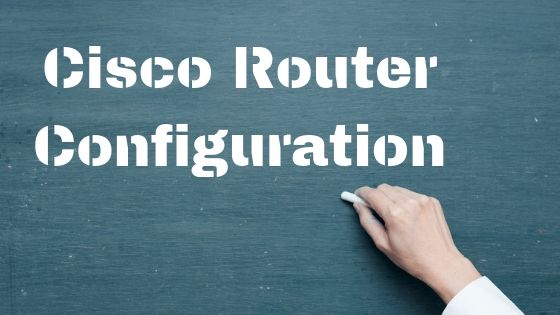
EIGRP Stub Routing
This article is about EIGRP (Enhanced Interior Gateway Routing Protocol) Stub Routing feature, in start you find basic concepts of EIGRP stub routing and then EIGRP stub leak-map later in article. Learn when EIGRP is suitable for your network.
EIGRP Stub-routing is commonly used in hub & spoke topology. Before we understand what the stub routing does we need to understand how EIGRP routing works internally. Checkout the topology diagram of network running with EIGRP we have two headquarter routers R1 & R2 which are connected with each other with the high speed LAN. Behind these two routers we have the enterprise network with all our LAN equipment. We have a remote or branch site having router R3 which connect to R1 & R2 with the WAN Links. In normal EIGRP Network if R1 lose any route from enterprise network then they are send queries about that network to R3 over the WAN links which may results the unnecessary traffic on WAN links, which we don’t want this in our network specially in this case where R3 exist on the end of network. And this really stub router means that I am the END of lines these is not router behind me, so don’t query about the missing routes. So if we configure R3 as stub router, in case of query regarding missing routes it will tell R1 & R2 that I have any other information except the routes I have told you.
Features of EIGRP Stub Routing
Stub routing does couple of different things.
- First of all Stub routing disable the unnecessary queries, this will cut down the bandwidth utilization on WAN links. You will enable the stub routing only on stub router and when you enable R3 as stub router it give the signals to R1 & R2 that I am the stub router and don’t start sending me queries when you are up because I don’t have those routes, I only have the routes which I told you.
- The other thing happen with EIGRP stub routing that R3 the stub router only advertise the summary and connected routes to neighbors. Suppose the link between R1 & R2 goes down in normal EIGRP configuration then in case if request from enterprise network wants to reach R2, they may start following it via the WAN link through R1 to R3 & R3 to R2 and then to enterprise network of company. This will also results in slow network traffic and response because may be R1 and R2 are connected to R3 with T1 line or 128 bit WAN link and there may have a high speed LAN route in enterprise network to reaching R2 which we don’t want to happen in network.
Types or flavor of Configuring Stub Routing:
Receive-only: In this case stub-router ll not advertise any network.
Summary: In this type stub-router can advertise summary-routes.
Connected: Allow stub-router, to advertise directly connected subnets .
Redistribute: Stub router will advertise the redistributed routes.
Static: Stub router will also advertise static-routes. (You can find it configuration example below in this post)
EIGRP stub command reference:
This is the basis of EIGRP stub routing it very easy to configure simply go to the router which you wants to configure as stub
Router eigrp 100
EIGRP stub
This will configure the router R3 as EIGRP stub and will advertise only connected router to its neighbors.
The way you verify the stub router, you will use the following command on neighbor.
show eigrp neighbor details
How to advertise the routes other then connected via a stub router
Add a static router on stub router with following command
ip route 1.1.1.0 255.255.255.0 35.35.35.1
router EIGRP 100
redistribute static metric 1 1 1 1 1
with the default configuration you will not find this route on neighbors router R1& R2 even you have done the redistribution. If you want to advertise the static routes via a stub router to its neighbors you will use the following commands.
router EIGRP 100
eigrp stub connected static
after this command you will find the static routes in neighbor router’s routing table
Following are some more commands for configuring different types of stub routing:
router eigrp 10
network 10.0.0.0
eigrp stub
——-
router eigrp 10
network 10.0.0.0 eigrp
eigrp stub receive-only
Learn more basic Cisco Commands
EIGRP stub & leak-map
Route leaking is a technique which is used for saving memory by summarizing different routes but still want some subnets to be preferred over others. With EIGRP Stub leak-map you can allow some of the routes to be advertised by using summary routes.
For More EIGRP concepts try this basic EIGRP concepts Quiz
















